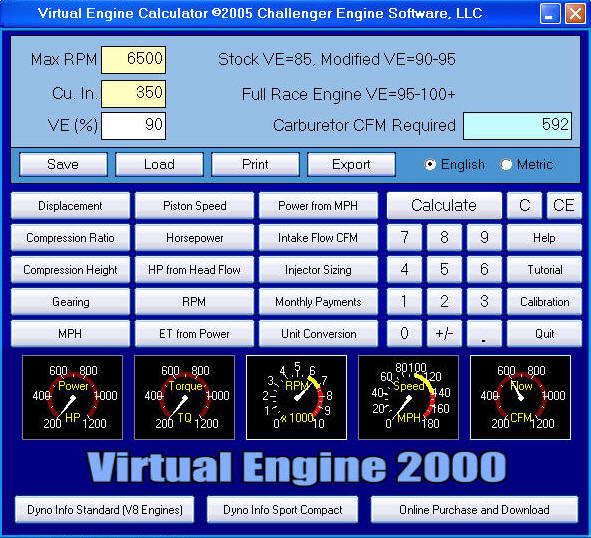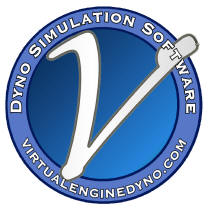Trying to do some equations, and can't find any info on search engines on how many cfm would go through a 4 brl carb on a 350 ci engine through the rpm range. The numbers would vary depending on the engine build, intake, exhaust, etc, but i'm just trying to get a ballpark # ?
You are using an out of date browser. It may not display this or other websites correctly.
You should upgrade or use an alternative browser.
You should upgrade or use an alternative browser.
Does anyone know how many CFM of air a 350 ci engine pumps over the rpm range ?
- Thread starter Kasey74
- Start date
This site may earn a commission from merchant affiliate links like Ebay, Amazon, and others.
CID/2=pumped volume per full revolution.
rpm and cfm are both per minute, so that simplifies things.
1728 cubic inches per cubic foot.
So: 350/2/1728=cfm per revolution= 0.101273148148148
At 6000 rpm it is 607.63888888888888 cfm.
This is based on 100% volumetric efficiency. Below torque peak you will pump less. At torque peak you will pump the maximum.
It is possible on a normally aspirated engine to pump more than 100%VE, if the pressure waves are tuned correctly.
rpm and cfm are both per minute, so that simplifies things.
1728 cubic inches per cubic foot.
So: 350/2/1728=cfm per revolution= 0.101273148148148
At 6000 rpm it is 607.63888888888888 cfm.
This is based on 100% volumetric efficiency. Below torque peak you will pump less. At torque peak you will pump the maximum.
It is possible on a normally aspirated engine to pump more than 100%VE, if the pressure waves are tuned correctly.
cool, thanks !
This site may earn a commission from merchant affiliate links like Ebay, Amazon, and others.
Damon
Veteran Member
Just keep in mind that carbs are CFM rated at 1.5" Hg of pressure drop (vacuum). The engine may only consume 600 CFM but that doesn't mean a 600 CFM carb will produce maximum power or torque. Ideally you want ZERO pressure drop across the carb (no vacuum), but that's not possible for obvious reasons. As close to zero as you can get while still having adequate signal at the boosters under all conditions to correctly meter the fuel is what you really want to shoot for. That's why typical carb sizing calculators can be misleading. Bigger carbs than formulas typically recommend often work best in the real world.
If you're looking at a vacuum secondary carb it's pretty much impossible to over-carb the engine. Stick as big a carb on it as you like. The Holley 3310 750 CFM unit is a popular choice for good reason. Stock QJets flow 750-800 CFM and yet GM put them on stock factory motors as small as 305ci without any problems.
Even for double-pumpers you can go pretty big. The limiting factor is how low an RPM you are going to lug it under WOT conditions. Against a low-stall stock converter a big DP can get pretty "doggy" for sure. But stall it up around 3000+ and you can put on some pretty big carbs, even on a little 350, and still make a ton of power from lauch through redline with no "soggies". I don't bat an eye putting 800+ CFM carbs on a hotted-up 383 with a 3000 stall converter.
If in doubt, go with the smaller carb- you won't give away much power. It's the safe choice. But if you pay attention to your overall combo you'll often find that a carb that is "too big" according to the usual calculations goes faster in the real world.
If you're looking at a vacuum secondary carb it's pretty much impossible to over-carb the engine. Stick as big a carb on it as you like. The Holley 3310 750 CFM unit is a popular choice for good reason. Stock QJets flow 750-800 CFM and yet GM put them on stock factory motors as small as 305ci without any problems.
Even for double-pumpers you can go pretty big. The limiting factor is how low an RPM you are going to lug it under WOT conditions. Against a low-stall stock converter a big DP can get pretty "doggy" for sure. But stall it up around 3000+ and you can put on some pretty big carbs, even on a little 350, and still make a ton of power from lauch through redline with no "soggies". I don't bat an eye putting 800+ CFM carbs on a hotted-up 383 with a 3000 stall converter.
If in doubt, go with the smaller carb- you won't give away much power. It's the safe choice. But if you pay attention to your overall combo you'll often find that a carb that is "too big" according to the usual calculations goes faster in the real world.
onovakind67
Veteran Member
RPM···········1500····2000····2500····3000····3500····4000····4500····5000····5500····6000
Brake_Tq······243·····294·····318·····334·····344·····345·····336·····317·····278·····229
Brake_HP······69.5····112·····152·····191·····229·····263·····288·····302·····291·····262
Exh_Pres······.1······.3······.5······.8······1.2·····1.6·····2.0·····2.4·····2.6·····2.8
Int_Vacuum····.2······.4······.6······.6······.6······.6······.7······.9······1.0·····1.0
Vol_Eff_%·····65.8····71.3····76.3····81.4····85.6····88.0····89.0····88.6····85.5····81.1
Actual_CFM····107·····155·····208·····266·····326·····384·····436·····483·····513·····530
Fuel_Flow·····39.3····56.8····75.9····97.2····119·····140·····159·····176·····187·····194
A/F_Mix_Qal···87.1····100.0···100.0···100.0···100.0···100.0···100.0···100.0···100.0···100.0
BSFC··········.565····.507····.501····.509····.520····.534····.553····.585····.643····.741
BSAC··········7.090···6.355···6.282···6.388···6.518···6.696···6.943···7.341···8.072···9.291
Friction_HP···12······20······29······40······54······69······88······113·····142·····178
Mach_#········.145····.194····.242····.291····.339····.388····.436····.485····.533····.582
Piston_Spd····870·····1160····1450····1740····2030····2320····2610····2900····3190····3480
Piston_Gs·····145·····258·····403·····581·····790·····1032····1306····1613····1952····2323
Overlap_%VE···-3.4····-2.5····-2.1····-1.8····-1.6····-1.4····-1.3····-1.1····-1.0····-.9
Int_AvgVel····94······126·····157·····189·····220·····252·····283·····315·····346·····378
In_InertiaPrs·.0······.3······.9······1.4·····1.9·····2.2·····2.3·····2.2·····2.0·····1.7
In_ResTunPrs··0.0·····0.0·····.0······.0······.0······.0······0.0·····0.0·····0.0·····0.0
Ex_AvgVel·····112·····149·····186·····224·····261·····298·····336·····373·····410·····448
ExTun_Prs·····2.6·····2.5·····2.4·····2.6·····2.8·····2.8·····2.6·····2.3·····2.1·····2.0
Brake_Tq······243·····294·····318·····334·····344·····345·····336·····317·····278·····229
Brake_HP······69.5····112·····152·····191·····229·····263·····288·····302·····291·····262
Exh_Pres······.1······.3······.5······.8······1.2·····1.6·····2.0·····2.4·····2.6·····2.8
Int_Vacuum····.2······.4······.6······.6······.6······.6······.7······.9······1.0·····1.0
Vol_Eff_%·····65.8····71.3····76.3····81.4····85.6····88.0····89.0····88.6····85.5····81.1
Actual_CFM····107·····155·····208·····266·····326·····384·····436·····483·····513·····530
Fuel_Flow·····39.3····56.8····75.9····97.2····119·····140·····159·····176·····187·····194
A/F_Mix_Qal···87.1····100.0···100.0···100.0···100.0···100.0···100.0···100.0···100.0···100.0
BSFC··········.565····.507····.501····.509····.520····.534····.553····.585····.643····.741
BSAC··········7.090···6.355···6.282···6.388···6.518···6.696···6.943···7.341···8.072···9.291
Friction_HP···12······20······29······40······54······69······88······113·····142·····178
Mach_#········.145····.194····.242····.291····.339····.388····.436····.485····.533····.582
Piston_Spd····870·····1160····1450····1740····2030····2320····2610····2900····3190····3480
Piston_Gs·····145·····258·····403·····581·····790·····1032····1306····1613····1952····2323
Overlap_%VE···-3.4····-2.5····-2.1····-1.8····-1.6····-1.4····-1.3····-1.1····-1.0····-.9
Int_AvgVel····94······126·····157·····189·····220·····252·····283·····315·····346·····378
In_InertiaPrs·.0······.3······.9······1.4·····1.9·····2.2·····2.3·····2.2·····2.0·····1.7
In_ResTunPrs··0.0·····0.0·····.0······.0······.0······.0······0.0·····0.0·····0.0·····0.0
Ex_AvgVel·····112·····149·····186·····224·····261·····298·····336·····373·····410·····448
ExTun_Prs·····2.6·····2.5·····2.4·····2.6·····2.8·····2.8·····2.6·····2.3·····2.1·····2.0
thats good info... i was looking for the numbers for sizing turbo's / superchargers 
I read something in one of the magazines (IOW, take this info with a grain of salt) that one of the keys to sizing a turbo is to determine how much power you want to make. Then you get a turbo that pumps the appropriate amount of air. So many CFM equals so much horsepower.
turbo sizing calculation ... http://www.gnttype.org/techarea/turbo/turboflow.html ... and a spreadsheet that you can enter info to, to get the proper turbo sizing... http://www.gnttype.org/techarea/turbo/turbocalcs.xls
Last edited:


